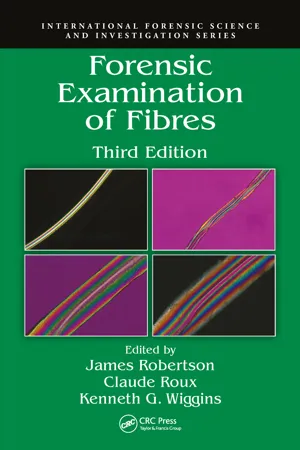
- 465 pages
- English
- ePUB (mobile friendly)
- Available on iOS & Android
Forensic Examination of Fibres
About this book
In order for forensic fibre examiners to fully utilize fibre and textile evidence during their analysis, they require not only specialised forensic knowledge but also in-depth knowledge of fibres, yarns and fabrics themselves. Production, both the chemical and physical structure, and the properties of these materials is required in order to determine the value of fibre evidence. This includes knowing production figures, fashion changes, sudden arrivals of new materials, dye variability, and numerous other factors that may have a bearing on the information obtained.
Fully updated with the latest advances, Forensic Examination of Fibres, Third Edition continues in the tradition of the First (1992) and Second Editions (1999) as the premier text on the subject of forensic fibre analysis. The international team of contributing authors detail the recovery of the evidence—through the different stages of laboratory examination—to the evaluation of the meaning of findings. The coverage has been considerably expanded, and all material, has been revised and wholly updated. Topics covered include examining damaged textiles, infrared microspectroscopy and thin layer chomatography, and colour analyses.
This edition also highlights the critical role of quality assurance in ensuring the reliability of the technical observations and results, and, in doing so, looks at the implications of supervisory managers and labs in the accurate and responsible analysis of such evidence.
Features include:
- Outlining evidentiary process from collecting and preserving the evidence at the crime scene through the laboratory analysis of fibres
- Detailing the latest developments and emerging technologies including Kevlar and other such advances in fibre technology
- Coverage of a broad array of fibres both, natural (cellulose, protein, and mineral) and man-made fibres including synthetic, inorganic and regenerated
Forensic Examination of Fibres, Third Edition is a much-needed update to the classic book, serving as an indispensable reference to crime scene technicians, laboratory forensic scientists and microscopists, students in police, forensic, and justice science programs.
Frequently asked questions
- Essential is ideal for learners and professionals who enjoy exploring a wide range of subjects. Access the Essential Library with 800,000+ trusted titles and best-sellers across business, personal growth, and the humanities. Includes unlimited reading time and Standard Read Aloud voice.
- Complete: Perfect for advanced learners and researchers needing full, unrestricted access. Unlock 1.4M+ books across hundreds of subjects, including academic and specialized titles. The Complete Plan also includes advanced features like Premium Read Aloud and Research Assistant.
Please note we cannot support devices running on iOS 13 and Android 7 or earlier. Learn more about using the app.
Information
FERGUSSON JANE HEMMINGS
| Industry | Uses |
| Medical | Bandages, swabs, sutures, absorbent cloths |
| Transport | Inflatables, ropes, canvas, sails |
| Mining | Conveyor belts, flexible ducting, sacks |
| Sports | Windproof fabrics, playing surfaces, Equipment |
| Furniture | Upholstery, netting, bedding, wadding |
| Horticulture | Netting, shade cloths, hail protection, Twine |
| Clothing | Sewing threads, hats, garments, shoes |
| Water | Hoses, membranes, filters |
| Chemical | Filter fabrics, vat liners, overalls |
| Architecture | Awnings, carpets, wall coverings, drapes |
| Aerospace | Glider fabric, parachutes, composites |
| Paper Making | Filtration aids, conveyors, felts |
| Automotive | Deat belts, drive belts, interior trims, insulaion |
| Civil Engineering | Road construction, retaining walls, soil separation, slings |
| Agriculture | Animal coats & collars, sacks, flexible silos |
| Defence | Camouflage, clothing, ballistic vests |

Table of contents
- Cover
- Half Title
- Series Page
- Title Page
- Copyright Page
- Contents
- Preface to second edition
- Preface to the third edition
- Editors
- Contributors
- 1 Fibres, Yarns and Fabrics: An Introduction to Production, Structure and Properties
- 2 Textile Damage Interpretation
- 3 Ropes and Cordages
- 4 From Crime Scene to Laboratory
- 5 Microscopic Examination of Fibres
- 6 Colour Analysis of Fibres
- 7 Infrared Microspectroscopy of Fibres
- 8 Raman Spectroscopy of Fibres
- 9 Other Instrumental Approaches to Fibre Examination
- 10 Interpretation of Fibre Evidence
- 11 Future Trends for Forensic Fibre Examination
- Index